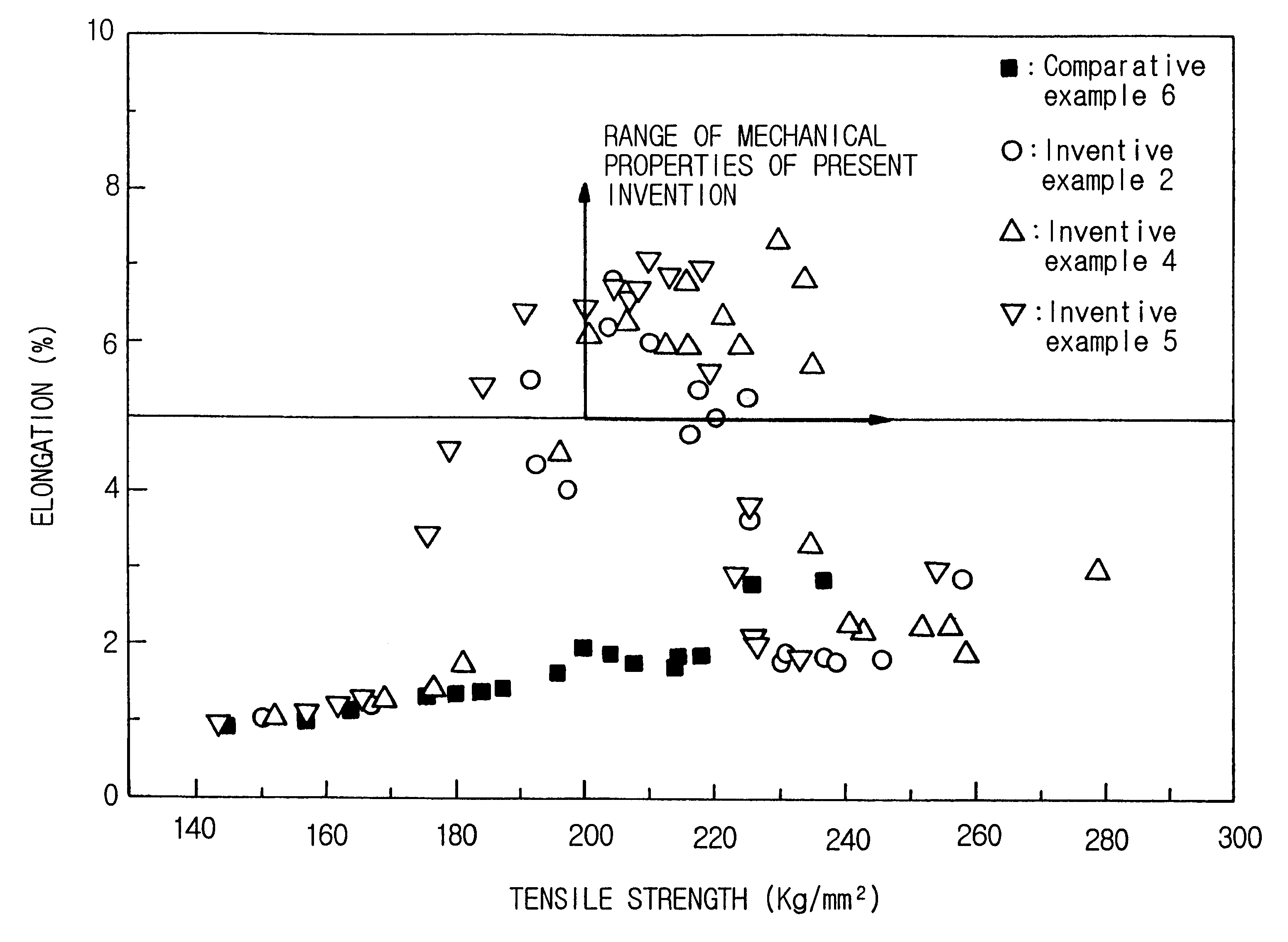Wire rods with superior drawability and manufacturing method therefor
a technology of drawability and manufacturing method, which is applied in the direction of manufacturing tools, furnaces, heat treatment equipment, etc., can solve the problems of reducing ductility, difficult to secure high strength, and raising strength
- Summary
- Abstract
- Description
- Claims
- Application Information
AI Technical Summary
Problems solved by technology
Method used
Image
Examples
example 2
For the respective wire rods of example 1, wire drawings were carried out to diameters of 5.5 mm to 0.96 mm. Then the strengths of the wires, the area reduction rates, the elongations and the occurrence of delaminations were checked. The checked results are shown in Table 2 below. For the drawing of the wire rods, the strain is defined to be .epsilon.=2 ln(Do / D), where Do is the diameter of the wire rods stock to be drawn, and D is the diameter after the drawing. In the present invention, the strain was about 3.5.
As shown in Table 2 above, the comparative example 1 was obtained by wire-drawing the comparative material a to a drawing strain of 3.5 without carrying out patenting. In this case, not only the tensile strength was low, but also delaminations occurred.
Meanwhile, in the cases of the comparative examples 2 and 4, the comparative materials b and c which were the wire rods for making the general high strength steel wire were drawn without carrying out patenting. When they were...
example 3
Wire rods were prepared like in Example 1, except that the comparative material a of Example 1 was heated to 1150.degree. C. In the case of the comparative material a in which the alloy elements were not added, the pro-eutectoid ferrite volume fraction was 6%, the tensile strength was 85.3 Kg / mm.sup.2, and the reduction of area was 59%. That is, in the case of the comparative material a in which the alloy elements were not added, a high temperature heating up to 1150.degree. C. was required if the pro-eutectoid ferrite proportion was to be maintained to below 10%.
Meanwhile, the wire rods thus obtained were drawn to a drawing strain of 3.5 without carrying out patenting like in Example 2, thereby obtaining steel wire with a diameter of 0.96 mm. Then the strength of the steel wire, the area reduction and the elongation were measured, and the measured results are shown in Table 3 below.
As can be seen in Table 3 above, in the case of the comparative example 6 in which the comparative ma...
example 4
From among the steel wires manufactured in Example 2, there were selected the inventive examples 2, 4 and 5 in which the delaminations did not occur. They were dipped into a Pb bath at a temperature of 400-550.degree. C. for 3-300 seconds, thereby carrying the bluing. Further, bluing was carried out on the steel wire of the comparative example 6 of Example 3 in which the delaminations did not occur.
After carrying out the bluing, the relationship of the tensile strengths of the wire rods to their elongations is illustrated in FIG. 2. It was the general trend that if the temperature of the Pb bath was raised, or if the treating time period was extended, then the tensile strength was lowered. As shown in FIG. 2, the comparative example 6 could not secure an elongation of 5% over the entire temperature and time ranges, while when the inventive examples 2, 4 and 5 were subjected to a bluing treatment at a temperature of 450-550.degree. C. for 2-60 seconds, there were obtained mechanical ...
PUM
| Property | Measurement | Unit |
|---|---|---|
| temperature | aaaaa | aaaaa |
| elongation | aaaaa | aaaaa |
| temperature | aaaaa | aaaaa |
Abstract
Description
Claims
Application Information
 Login to View More
Login to View More - R&D
- Intellectual Property
- Life Sciences
- Materials
- Tech Scout
- Unparalleled Data Quality
- Higher Quality Content
- 60% Fewer Hallucinations
Browse by: Latest US Patents, China's latest patents, Technical Efficacy Thesaurus, Application Domain, Technology Topic, Popular Technical Reports.
© 2025 PatSnap. All rights reserved.Legal|Privacy policy|Modern Slavery Act Transparency Statement|Sitemap|About US| Contact US: help@patsnap.com

